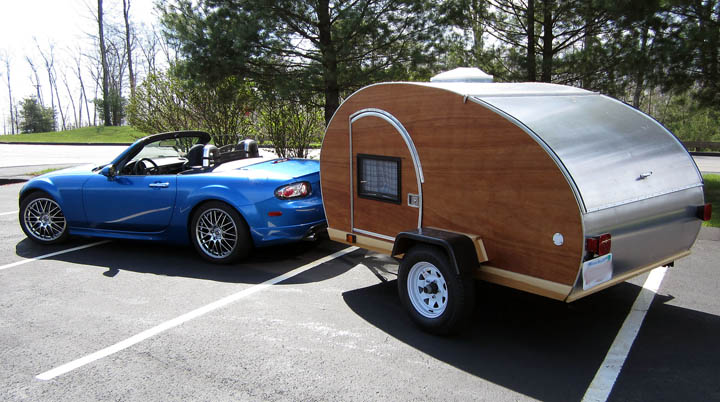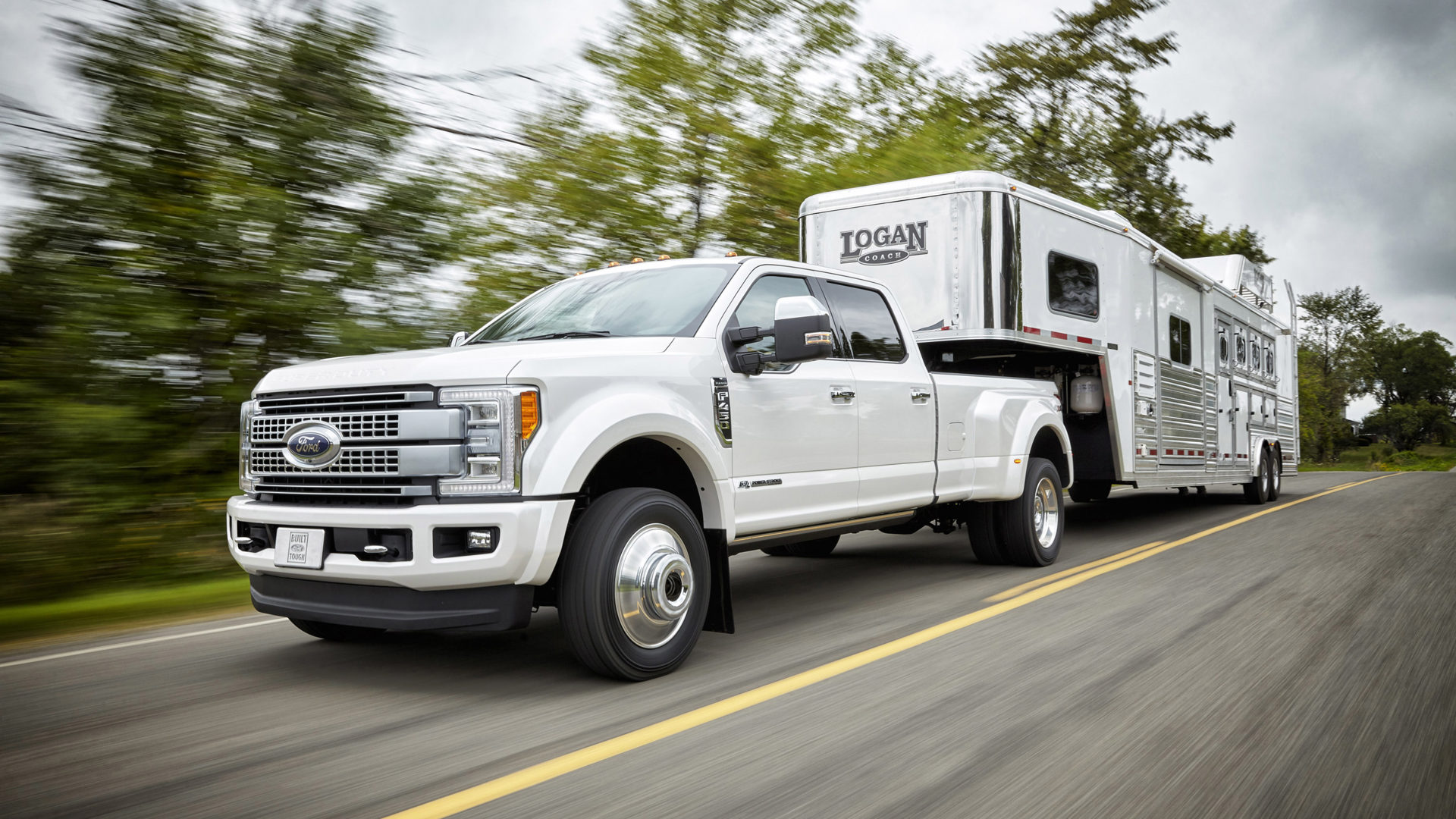It’s finally here. The first long weekend of the summer has arrived and you’re ready to go. You got a shiny new tow rig over the winter, and you’ve been itching to use your PowerMaxMmins F-4800 Eco-Force. So you’ve loaded up your trailer. Maybe it’s a travel trailer, maybe there’s a race car on there, a trailer full of topsoil for landscaping, or maybe it’s a fancy new boat or some ATVs.
You’re off! Exploring Canada’s highways and byways by yourself or with the family, with that great big trailer coming along smoothly behind you. But do you have the right driver’s license and vehicle registration for that trailer? Do you have the right inspections? Modern trucks like Ford's 2017 F-450, the 2017 Chevrolet Silverado 3500HD, and the 2017 Ram 3500 can tow well over 13,000 kg, but depending on your province, your licence might not be able to handle the load.
Some limit you to as little as 4,500 kg. That’s why we’ve spent days scouring motor vehicle rules and spent hours on hold with departments of motor vehicles across the country. To get you the information you need to stay legal while towing this summer. If you’re driving a motorhome, we’ve got you covered there too. Just keep in mind that if you’re towing something behind it that you’ll have to follow both sets of rules. And as always, laws can change and your unique situation could be different, so if you aren’t sure, contact the licensing people in your province before you leave the driveway.
Every province has slightly different requirements for towing a trailer or an RV behind your truck. It ranges from Alberta, where you need a class 5 license and that’s it, to Ontario, where you need to have passed the bar to even begin to decipher all of the rules. Fortunately, you only have to worry about the licence rules for your home province. Here’s a look at the ones in between, keeping in mind that these are the rules for personal use only, not for business or commercial towing.

Newfoundland lets you tow any trailer weighing up to 4,500 kg with a regular class 5 licence. This is a common number and is shared with PEI, NS, and NB. Other provinces are similar, with Manitoba at 4,540, the Yukon placing that limit at 4,550 kg, and BC and SK putting it at 4,600 kg.
Above that magic number, things start to get more complicated. If you want to save a lot of hassle, stay under that magic mark for your trailer maximum weight.
If you want to tow something heavier, you’ll need at least an endorsement on your current license. Most of them need a different road test, some of them even need a medical exam. Nova Scotia will let you drive any single vehicle up to 14,000 kg gross weight (total weight of the loaded vehicle), but to tow a trailer requires you to add a Condition 15 endorsement. That covers you for heavier trailers.
You’ll need to pass a test with a trailer, but no medical is required. BC lets you drive any motorhome with a class 5, but changes things up, depending on if you’re towing an RV or a trailer. A heavy RV trailer needs a Code 7, which doesn’t need a medical. A heavy regular trailer, like a car hauler, requires a Code 20, which does. Both need you to complete a road test. Saskatchewan gives a G01 endorsement that lets you tow over 4,600 kg with a road test.
Yukon requires a heavy trailer endorsement that needs a road test but will let you tow heavy loads.

The Northwest Territories and Nunavut require a class 3 license to tow up to 4,500 kg combination weight, or drive any three axle motorhome. Two axle motorhomes under that weight are ok with a class 5. To tow over 4,500 kg combined, you need a class 2 licence.
Quebec will let you drive any motorhome, and any truck with an empty weight of less than 4,500 kg. That should cover any current pickup. If you are towing in Quebec, and your gross vehicle weight rating (GVWR, the total amount it can carry including the vehicle, occupants, and cargo) is more than 4,500 kg you need to stop at inspection stations when the lights are flashing. That GVWR is right in the middle of the 2500/250 truck group, so check the specific GVWR on your door plate to know if you have to stop.

I’m saving Ontario for last because Ontario is complicated. But if you live in Ontario, you already knew that.
In Ontario, a class G licence allows you to tow up to 4,600 kg. It also lets you have a combined weight (your truck plus your trailer) of up to 11,000 kg. To tow more than 4,600 kg, you'll need to upgrade to a class A licence.
There is an exception to that for towing house trailers. You can tow a house trailer (or travel trailer) heavier than 4,600 kg using a class G licence if you meet all of these conditions: your truck weighs less than 11,000 kg, has a GVWR of less than 6,000 kg, has a stock-appearing box (no flatbeds), and uses a fifth-wheel hookup.
But it gets more complicated. Technically, Ontario considers all pickups to be commercial motor vehicles. So if you're towing, then you might need more than just a higher license. If your trailer and truck together weigh more than 4,500 kg, then your truck and trailer need an annual inspection.
If your truck's GVWR is over 6,000 kg (and many heavy duty trucks are) then you need an annual inspection if you tow or not.
If your truck’s registered weight (on the vehicle registration paper) is over 4,500 kg, you need an annual inspection.
A truck over 6,000 kg GVWR towing a trailer will need commercial vehicle operators registration and the driver will need a Class A license. That means that you need to have a medical, do daily inspections, and follow hours of service rules.
However, a vehicle with a 6,000 kg GVWR that is towing a trailer will be exempt from the daily inspection and hours of service auditing requirements if used for solely private use. You will still need an annual inspection and a Class A license (which requires a medical) to operate your truck/trailer combination, but won't need to keep a log book or perform trip inspections.
Motorhomes under 11,000 kg are fine with a class G licence, but over that needs a class D. All of the trailer towing rules still apply if you have a trailer.
Some provinces require inspections for your car or truck. I’ve included Ontario’s rules in with their licensing rules, but here are the rest.
NL requires trucks and trailers (other than travel trailers) with a mass on the registration permit of more than 4,500 kg to get an inspection every year. NS requires a biennial inspection if under 4,501 kg registered weight for trucks and trailers and an annual one over that weight. NB and PEI require annual inspections. Manitoba requires an annual inspection for trucks over 4,500 kg GVWR, but not motorhomes. BC requires an inspection if the gross weight is over 8,200 kg. In Quebec, motorhomes need an annual inspection, as do personal use trucks with an empty weight over 4,000 kg.

Summary of licensing and inspection requirements by province:
NL: Motorhome (any), trailer up to 4,500 kg = class 5. Heavier: call Service NL. Annual inspection over 4,500 kg registered weight.
PEI: Motorhome (up to 14,000 kg), trailer up to 4,500 kg = class 5
Trailer over 4,500 kg = Class 3. Medical required.
Annual inspection required
NS: Motorhome (up to 14,000 kg), trailer up to 4,500 kg = class 5
Trailer over 4,500 kg = Endorsement.
Annual inspection required over 4,501 kg registered weight. Bi-annual under.
NB: Motorhome (any), trailer up to 4,500 kg = class 5
Trailer over 4,500 kg = class 3. Medical required.
Annual inspection
PQ: Motorhome (any), two-axle truck (up to 4,500 kg empty weight) = class 5
Towing with GVWR over 4,500 kg = stop at inspection stations when open.
Motorhome (any), truck over 4,000 kg empty = annual inspection
ON: Motorhome (up to 11,000 kg), trailer up to 4,600 kg (11,000 kg combined) = class G
Fifth-wheel house trailer over 4,600 kg AND truck GVWR under 6,000 kg = class G
Motorhome over 11,000 kg = Class D
All others = class A
Truck over 6,000 kg GVWR = CVOR
MB: Motorhome (2-axle), trailer up to 4,540 kg = class 5
Motorhome (3-axle), trailer over 4,540 kg = class 3. Medical required
Trucks GVWR over 4,500 kg = annual inspection
SK: Motorhome (any), trailer up to 4,600 kg = class 5
Over 4,600 kg = endorsement G01
AB: Class 5 for all personal use towing or motorhome.
BC: Motorhome (any), trailer up to 4,600 kg = class 5
RV trailer over 4,600 kg = Code 7
Trailer over 4,600 kg = Code 20. Medical required.
Over 8,200 kg empty weight = Annual inspection required.
YK: Motorhome (2-axle up to 11,000 kg), trailer up to 4,550 kg = class 5
Motorhome (3-axle, over 11,000 kg) = class 3
Trailer (over 4,550 kg) = Heavy Trailer endorsement
NWT/NU: Motorhome (2-axle, under 4,500 kg) = class 5
Motorhome (3-axle), trailer under 4,500 kg combined truck and trailer = class 3
Trailer over 4,500 kg combined weight = class 2

